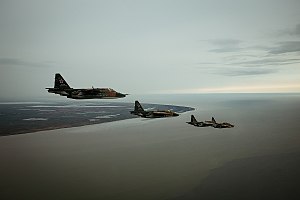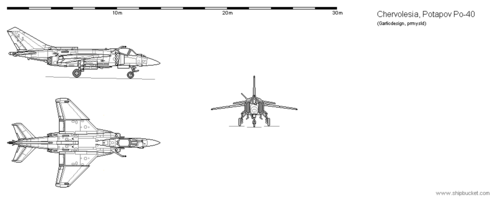Ilchenko Il-31
| Potapov Po-40 | |
|---|---|

| |
| Role | Attack aircraft |
| National origin | Chervolesia |
| Manufacturer | Aero Pereval |
| Designer | Potapov Design Bureau |
| First flight | 1976 |
| Introduction | 1977 |
| Status | In service |
| Primary user | People's Liberation Army Navy |
| Produced | 1977-2003 |
| Number built | 567 |
| Developed from | Potapov Izd 52 |
The Potapov Po-40 (Yavorstri: Потапов По-40; AFDC reporting name: Falchion) is a single-seat carrier-based all-weather attack aircraft developed by Potapov Design Bureau and manufactured by Aero Pereval.
The Po-40 was developed from the experimental vertical take-off and landing (VTOL) Izd 52 after the latter was rejected by the People's Liberation Army Navy. This new design was quickly adopted as a light and economical supplement to the Potapov Po-35 strike fighter in-service with both carrier aviation and ground-based squadrons. At the time of its adoption in 1977, it was the first Chervolesian combat aircraft to be outfitted with a fuel-efficient turbofan engine.
367 frames would be produced over the course of its 26 year production lifespan. Six main variants would be developed: the base Po-40 introduced in 1977, the land-based Po-42 introduced in 1979, the Po-40M introduced as a midlife upgrade in 1989, the Po-42M introduced in 1989, the further improved Po-40MU introduced in 2000, and Po-42MU introduced in 2001. The Po-40 remains in active service with the People's Liberation Army Navy and several other nations around the world.
Design and development
Design and testing
Over the course of the 1960s and early 1970s, Potapov built a series of experimental vertical take-off and landing (VTOL) fighters intended to replace the Potapov Po-34 in service with the People's Liberation Army Navy. These designs ultimately led to the Potapov Izd 52 (Potapov Test Object No. 52), which conducted its first test flight in 1971. Not wanting to abandon its nascent conventional take-off and landing (CTOL) aircraft carrier program to be abandoned in favour of less capable aviation cruisers, the People's Liberation Army Navy rejected Potapov's design. The reasoning given for the Izd 52's rejection was its poor hardpoint load capacity, which was rated at only 2,000 kg (4,400 lb). The Izd 52's was only designed with four hardpoints, one or two of which would already be in use by mounting a UKP-23-250 gun pod. This left only two hardpoints free at any given time, which was determined by People's Liberation Army Navy representatives as being too few for any serious combat missions.
In a rare case of Chervolesian defence industry initiative, Potapov attempted to salvage the Izd 52 design by converting the aircraft into a CTOL trainer as a replacement for the Anoshkin An-27UTI that had been in service since 1953. A single-seat, light strike fighter variant was derived from the initial design as an afterthought for export. Both the trainer and strike derivative received the OKB designation Po-108. The resulting design resembled the Izd. 52 externally, but had a shorter hull due to the removal of the lift fans (as they were no longer required), and wider wings that gave the design good low speed flight characteristics. The hardpoints were also improved, being able to carry 800 kg (1,765 lb) of ordnance; improving the overall capacity of the aircraft to 3,200 kg (7,055 lb)
A new engine needed to be selected for the new design. There was also some debate at the design bureau as to whether the new aircraft should be a twin-engine or single-engine configuration. Ruslan Kulagin, chief designer and project lead for the Po-108, was initially favorable to a single-engine design; believing the single-engine would help reduce cost, minimize the aircraft's weight, and increase maneuverability. Past experience with single-engine aircraft like the An-27 and Yartsin Yar-21 had revealed that relatively frequent problems with burnouts and other failures, in part due to the inconsistent quality of Chervolesian produced engines. A twin-engine design was ultimately chosen, as the failure of one of the two engines would still allow the aircraft to return to base. The engine chosen for the Po-108 was a reheated Osokin AM-32, the AM-32 being a tried engine that enjoyed both domestic and export success. The reheated engine allowed the aircraft to be transonic, giving a speed of Mach 1.3 at altitude.
The Po-108 first flew in the summer of 1976 at the Rzhavets Proving Grounds. Flight tests showed the Po-108 possessed great agility and excellent low altitude flight characteristics. With the new engines, a combat radius of 800 km (500 mi) was achieved with a full external payload, almost as much as the in-service Po-35 and with only a 20% reduction in payload size. Although Chervolesian naval aviation had no real requirement, the Po-108's simplicity and compact size made it an attractive choice. Unlike the Po-35, the Po-108 was capable of flying low-low-low mission profiles, allowing it to evade much of the AFDC's defensive measures, which were tailor made to counter high-altitude saturation strikes. Based on these considerations, the Po-108 was commissioned as the Po-40 in 1977.
Production
The Po-108's final prototype was ordered into production in September, 1977, with 100 airframes ordered by the People's Liberation Army Navy, half of which were to be trainers. Deliveries were processed between 1978 and 1979, with the first full-strength Po-40 squadron being stationed to the Volosovo on 19 May, 1978. The initial order was completed on 31 October, 1979, and a follow up order for an additional 100 aircraft was placed the following day.
Design
Armament
Powerplant
Variants
Carrier-based
Land-based
Operational history
Current Chervolesian inventory
Operators
Specifications (Po-40MU)
General characteristics
- Crew: 1
- Length: 13.8 m (45.1 ft)
- Wingspan: 8.1 m (26.6 ft)
- Height: 4.7 m (15.4 ft)
- Empty weight: 5,500 kg (12,125 lb)
- Loaded weight: 10,000 kg (22,050 lb)
- Max. takeoff weight: 11,630 kg (25,640 lb)
- Powerplant: 2 × Osokin AM-32 afterburning turbofan
- Dry thrust: 24 kN (5,395 lbf) each
- Thrust with afterburner: 36 kN (8,093 lbf) each
Performance
- Maximum speed: Mach 1.6 (1,975 km/h; 1,228 mph)
- Combat radius: 800 km (500 miles) on internal fuel
Armament
- Guns: 2× MTs-23 autocannon, 120 rounds each
- Hardpoints: 6 hardpoints with a capacity of 4,500 kg and provisions to carry combinations of:
- Rockets:
- UB-32 rocket pods
- B-8M rocket pods for S-8 rockets
- S-13
- S-24
- S-25
- Missiles:
- Bombs:
- Rockets:
Avionics
RP-21 Sapfir

